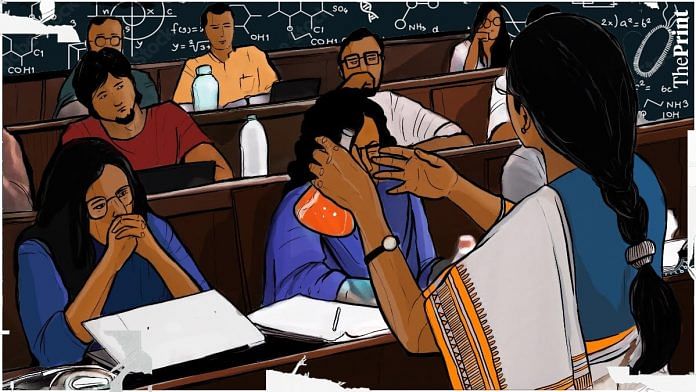New Delhi: Less than one in five STEM faculty members in India are women, research by BiasWatchIndia, an initiative that documents women’s representation in the field of science, has found.
According to the study, published on preprint repository bioRxiv and yet to be peer-reviewed, women account for 16.6 percent of Indian STEM (science, tech, engineering and maths) faculty members, with fields like engineering and chemistry recording the worst gender disparity.
The study has also pointed out that gender representation is worse among the STEM institutes ranked best in the National Institutional Research Framework (NIRF), including IITs and IISc, at just 10 percent of the faculty.
BiasWatchIndia was started in 2021 by Shruti Muralidhar and Vaishnavi Ananthanarayanan — both scientists, based in Canada and Australia, respectively — with an intention to track gender bias in science conferences and meetings.
“Indian science academia has a dearth of women researchers at all levels. Not only are they underrepresented, but they are also under-highlighted, under-mentored and overlooked for awards, grants and other career-advancing steps,” the duo wrote in their paper.
In order to address the issue, they decided to collect data on women’s representation at the faculty level in Indian STEM academia.
This was done by looking up the proportion of women faculty across 98 universities and institutes through their individual websites, which host this information.
The researchers then calculated the ratio of the number of women faculty members to the total number of faculty members — overall and field-wise — to come up with ‘base rates’.
For example, the base rate for women’s representation in Indian STEM faculty was 16.6 percent overall.
The gender disparity, according to the paper, is more pronounced in certain fields — the base rates for engineering and chemistry were just 8.3 percent, the worst of all fields. The highest representation of women faculty, with a base rate of 22.5 percent, was in biology.
The base rate was 16.4 percent for mathematics, 16.6 percent for physics, and 10.9 percent in computer science, the paper says.
Also Read: More women students now study STEM courses in IITs, NITs & other universities, shows govt data
Worrying findings
Among the notable findings of the study is that prestigious institutions with high NIRF rankings — such as Indian Institute of Science (IISc), Tata Institute of Fundamental Research (TIFR) and the Indian Institutes of Technology (IITs) at New Delhi, Roorkee, Mumbai and Kharagpur — struggle with gender parity.
The data indicated that the top eight NIRF-ranked STEM institutes fell below the overall base rate (16.6 percent), with women comprising just 10 percent of their faculty.
Another significant finding was the attrition of women faculty members throughout their careers.
According to the research, 46.3 percent of women faculty members in the surveyed institutes were early-career, 27.5 percent were mid-career, while 26.2 percent were senior-career. This, the paper says, illustrates a “leaky pipeline” that leads to women leaving STEM academia at various career stages.
The researchers also tracked gender representation in Indian STEM conferences and meetings in two phases — June 2020 to August 2021, and August 2021 to March 2023 — sampling 417 events.
The results of this analysis appeared to track with the frequent criticism directed at these conferences, that women are severely underrepresented on their panels.
In the first phase, 39 percent of the conferences covered had zero women speakers, while 54 percent had fewer women speakers than warranted by the base rate for their respective fields.
Mathematics conferences were found to be particularly problematic — with 80 percent featuring no women speakers.
There was just a slight improvement in the second phase — 26 percent of the conferences covered had no women speakers, and 55 percent had fewer women speakers than the base rate for their field.
According to the BiasWatchIndia team, their paper underscores the urgent need for measures to address gender disparities in Indian STEM academia and conferences. To combat these issues effectively, they have put forth a number of recommendations.
This includes removing age limits for early-career grants and positions to eliminate barriers that disproportionately affect women’s careers. They also recommend establishing mentorship and sponsorship programmes, regular training and workshops for staff and faculty members to challenge ingrained sexism in academic settings.
The team also suggests that at least 30 percent of panel members for various decisions, including recruitment and promotions, should be women scientists to promote diversity in decisionmaking processes.
Academic institutions should also provide on-campus childcare facilities to support new parents, alleviating one of the major stressors for women scientists, they suggest.
(Edited by Sunanda Ranjan)
Also Read: More Indian women in STEM but few are becoming leaders. Hard to retain them in workforce



